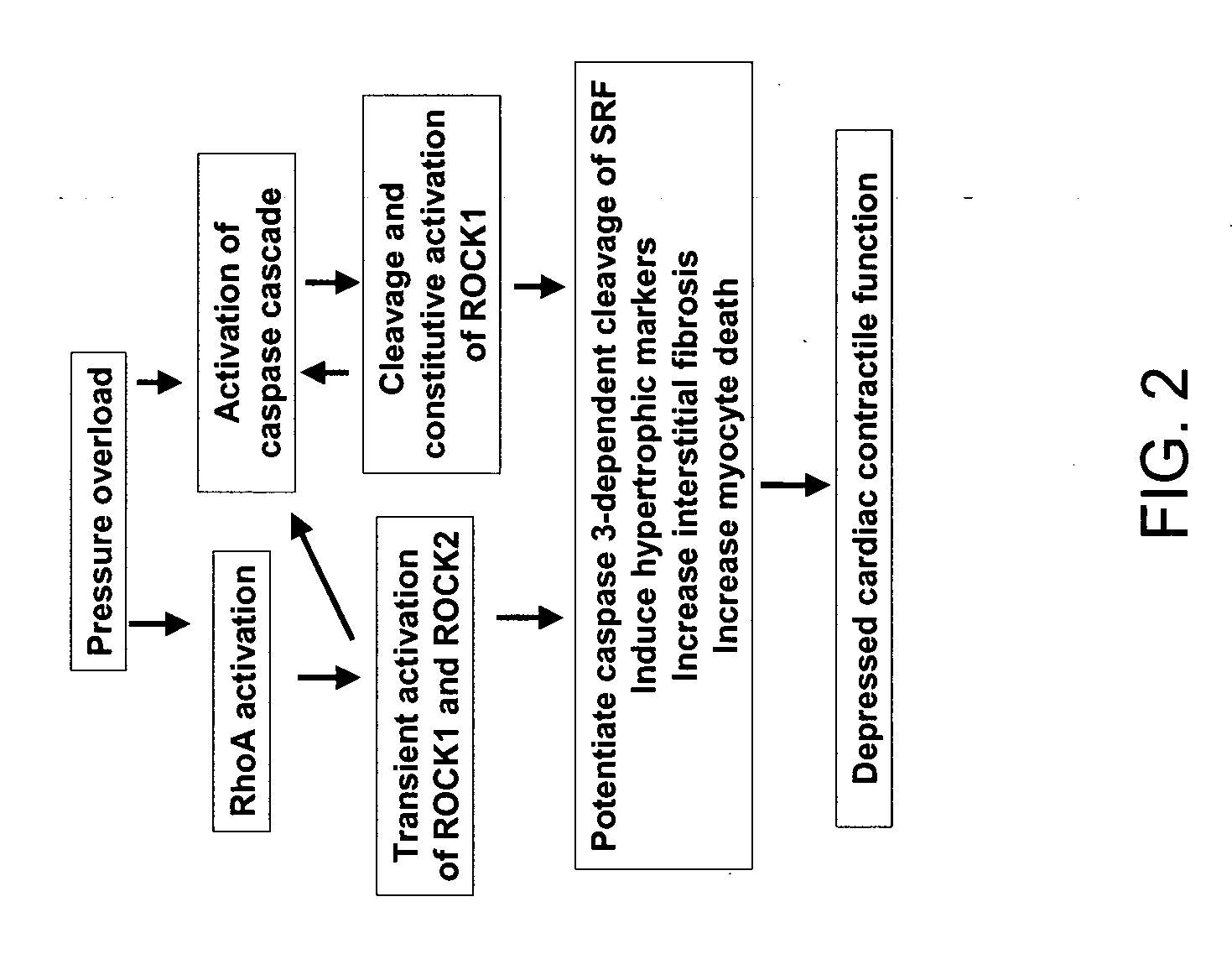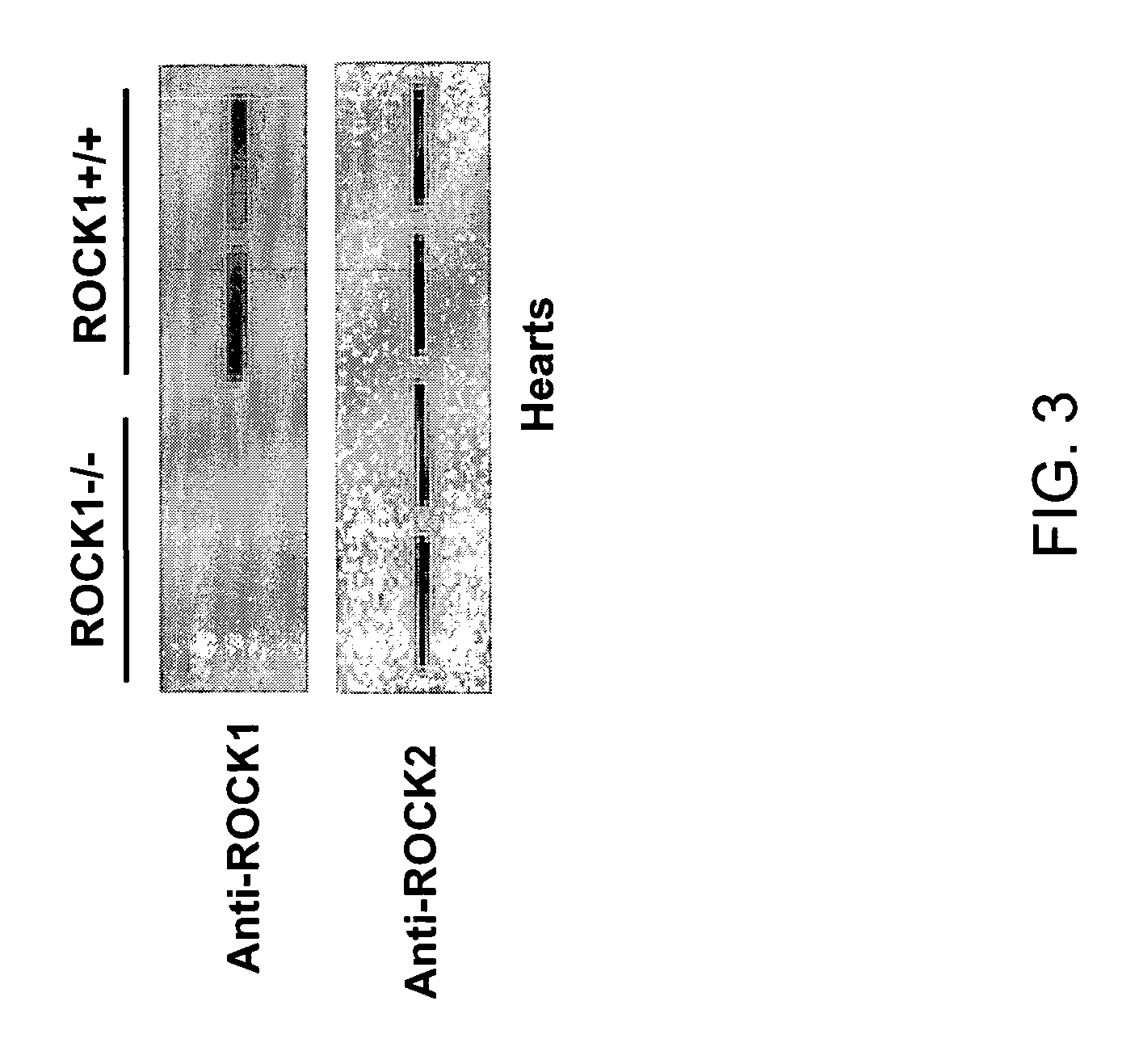Selective inhibition of rock1 in cardiac therapy
a technology of selective inhibition and rock1 in cardiac therapy, applied in the field of cell biology, molecular biology, medicine, can solve problems such as heart failure or sudden death
- Summary
- Abstract
- Description
- Claims
- Application Information
AI Technical Summary
Benefits of technology
Problems solved by technology
Method used
Image
Examples
example 1
Role of Rho Kinase in Mediating Hypertrophic Responses Under Pressure Overload
[0255] Rho kinase inhibitor, Y27632, inhibits protein kinases A and C, but with about 200 times lower affinity than that for Rho kinase (Uehata et al., 1997; Ishizaki et al., 2000). Using this compound and fasudil, another chemical Rho kinase inhibitor, several studies suggest that Rho kinase inhibitors may have therapeutic benefits for the treatment of hypertension, vascular proliferative disorders and cancer (Kuwahara et al., 1999; Uehata et al., 1997; Itoh et al., 1999; Sawada et al., 2000). To investigate the role of Rho kinase in mediating hypertrophic responses under pressure overload, the present inventors employed a genetic approach, which provides more direct and conclusive evidence than Y27632 treatment and allows determination of potential differential effects of Rho kinase isoforms.
[0256]FIG. 3 demonstrates expression analysis of ROCK1 and ROCK2 in ROCK1 homozygous knockout adult hearts. Two ...
example 2
Generation of ROCK1 Knockout Mice
[0257] ROCK1 was knocked out because of its enriched expression pattern in the mouse developing heart (Wei et al., 2001). ROCK1 knockout mice were successfully generated. The coding sequence of β-galactosidase was inserted in frame downstream of residue 180 followed by PGK-Neo. As the entire kinase domain is contained within residues 76-338, the majority of the kinase domain and the following coiled-coil and the PH domains are knocked out. Two independent ES clones have shown transmission through the germ line to establish heterozygous ROCK1+ / − mouse strains. Homozygous knockout mice are viable and morphologically indistinguishable from wild-type littermates. This lack of cardiac phenotype in ROCK1 homozygous knockout mice was not totally unexpected, due to the presence of ROCK2 (FIG. 3).
[0258] ROCK1-deficient mice develop cardiac hypertrophy in response to pressure overload (FIG. 4). The absence of a developmental cardiac phenotype in ROCK1 knocko...
example 3
ROCK1 Deficient Mice Exhibit Reduced Hypertrophic Marker Induction, Reduced Apoptosis and Improved Cardiac Contractile Functions Compared to Control Mice in Response to Pressure Overload
[0260] Pathological cardiac hypertrophy is characterized by a prototypical change in gene expression patterns such as ANF, BNP, βMHC and skeletal α-actin. Interestingly, the increases in the expression of these hypertrophic markers in ROCK1− / − mice were significantly lower than in control mice in response to pressure overload (FIG. 5). These results indicate that pressure overload induces cardiac hypertrophy in ROCK1− / − mice and produces reduced pathological changes in the gene expression profile compared to control mice.
[0261]FIG. 5 demonstrates real-time RT-PCR analysis of cardiac hypertrophic markers. RNA samples were prepared from ROCK1− / − and control hearts after three-week aortic banding (n=3-4 for each group). Quantitative RT-PCR analysis was performed using the ABI Prism 7700 sequence detec...
PUM
| Property | Measurement | Unit |
|---|---|---|
| Fraction | aaaaa | aaaaa |
| Pressure | aaaaa | aaaaa |
| Electrical resistance | aaaaa | aaaaa |
Abstract
Description
Claims
Application Information
 Login to View More
Login to View More - R&D
- Intellectual Property
- Life Sciences
- Materials
- Tech Scout
- Unparalleled Data Quality
- Higher Quality Content
- 60% Fewer Hallucinations
Browse by: Latest US Patents, China's latest patents, Technical Efficacy Thesaurus, Application Domain, Technology Topic, Popular Technical Reports.
© 2025 PatSnap. All rights reserved.Legal|Privacy policy|Modern Slavery Act Transparency Statement|Sitemap|About US| Contact US: help@patsnap.com



